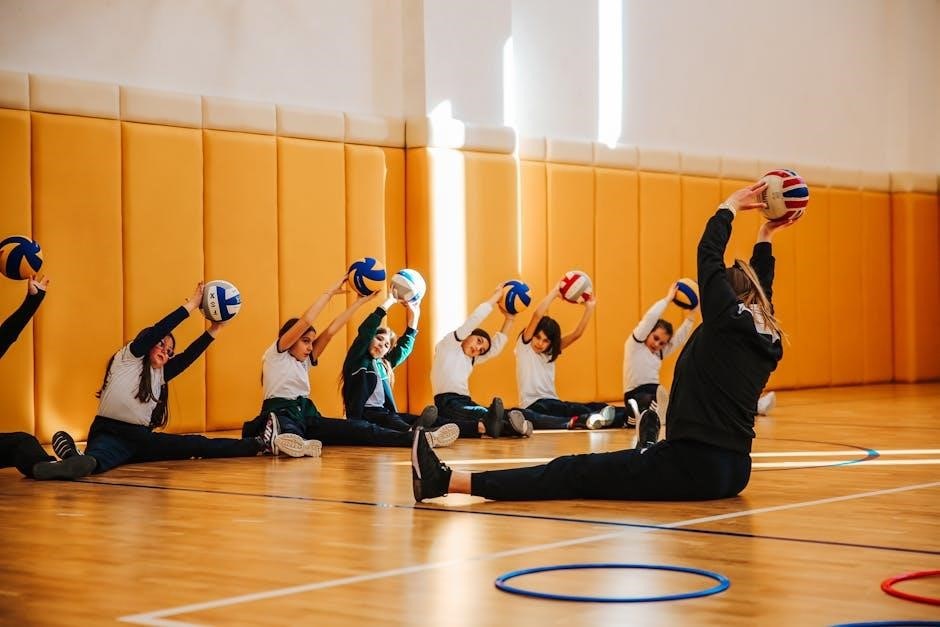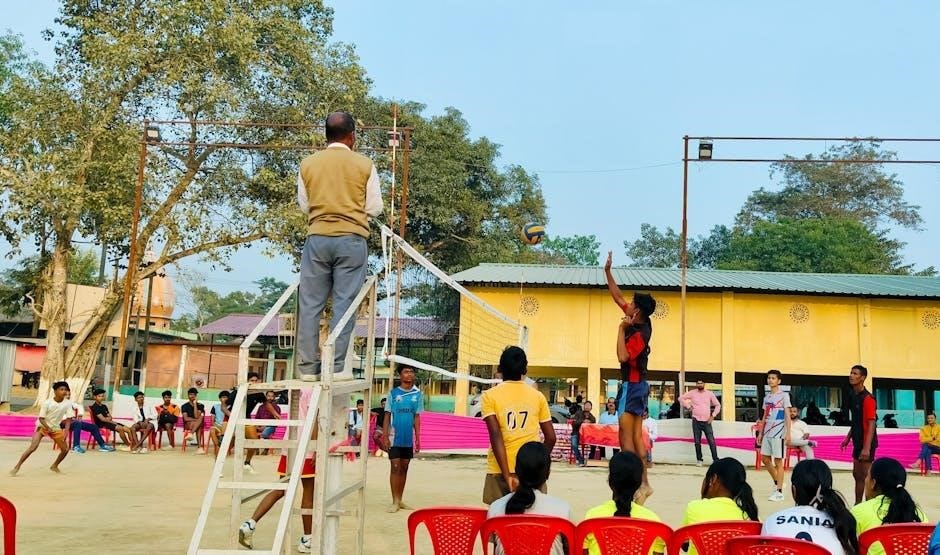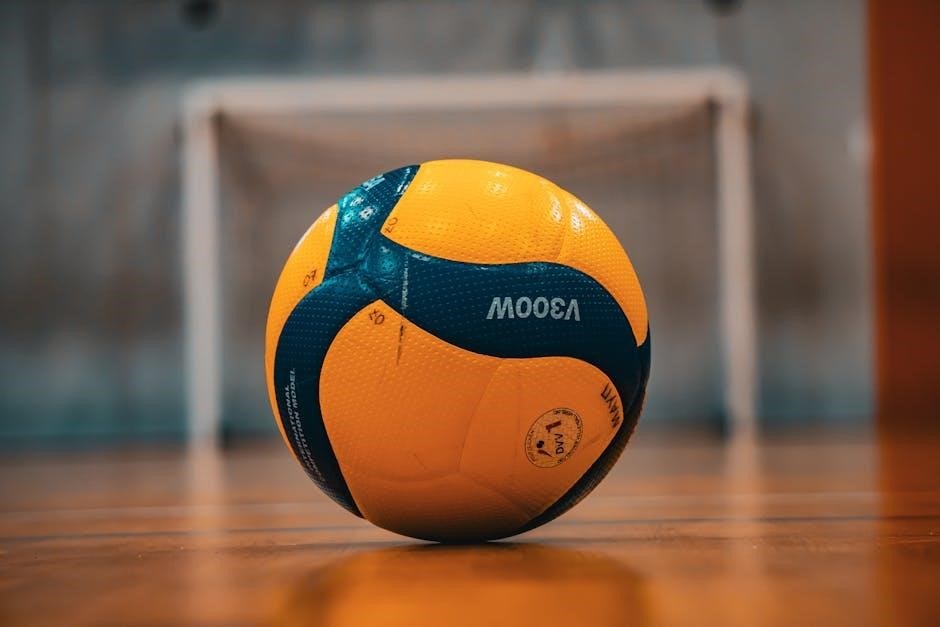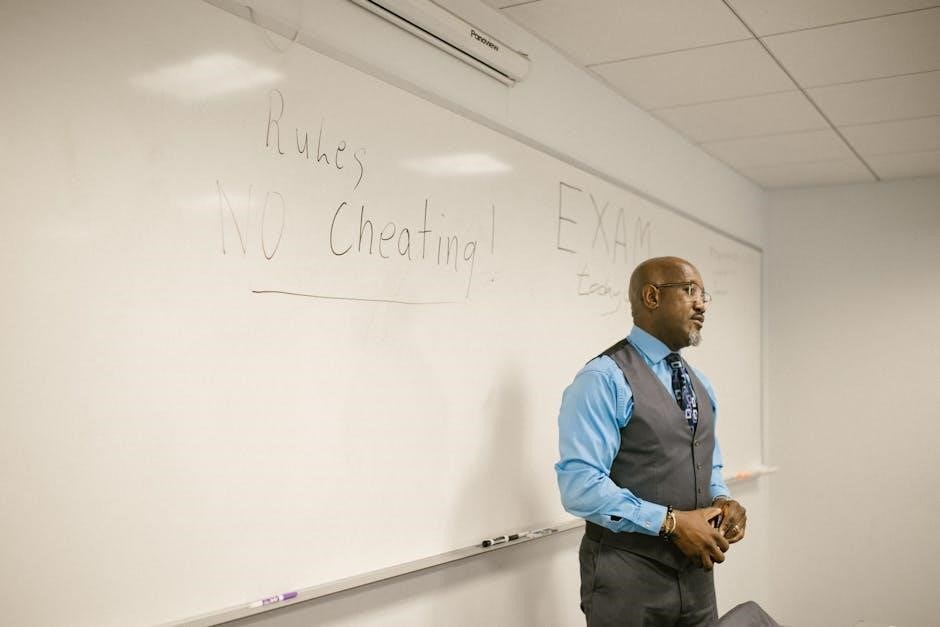High School Volleyball Rules: A Comprehensive Guide (2025-2026)
Understanding the intricacies of scholastic volleyball necessitates accessing official rules publications, including detailed rule books and manuals, designed to clarify regulations for high school play․
These resources, often available as a PDF, outline eligibility, gameplay, scoring, and conduct expectations for athletes and coaches during the 2025-2026 season․
Welcome to a detailed exploration of high school volleyball regulations for the 2025-2026 season! This guide serves as a foundational resource for players, coaches, officials, and enthusiasts seeking clarity on the sport’s governing principles․
Navigating the complexities of volleyball requires a thorough understanding of the official rules, often conveniently compiled in a comprehensive PDF document․ These documents, published by governing bodies, detail everything from player eligibility and team composition to gameplay mechanics and scoring procedures․
Adherence to these rules ensures fair play, promotes athlete safety, and fosters a positive competitive environment․ Understanding the nuances of these regulations is crucial for successful participation and appreciation of this dynamic and exciting sport․ Accessing the official PDF is the first step towards mastering the game!
Governing Bodies and Rulebooks
Several organizations oversee high school volleyball, establishing and maintaining the rules of the game․ In the United States, the National Federation of State High School Associations (NFHS) plays a pivotal role, with many states adopting their guidelines․
These governing bodies publish official rule books, often available for download as a PDF, which serve as the definitive source for all rules interpretations․ These publications include detailed explanations, case studies, and diagrams to aid understanding․
Additionally, individual state high school athletic associations may implement modifications or amendments to the NFHS rules․ Therefore, it’s essential to consult both the national PDF and your state’s specific regulations for complete compliance and a thorough grasp of the applicable rules for the 2025-2026 season․
Player Eligibility Requirements
Determining player eligibility in high school volleyball centers around enrollment and attendance at a member school of the governing athletic association, like the CSAA․ A student-athlete must be currently enrolled and actively attending classes to participate․
Detailed eligibility rules, often outlined in official rule books available as a PDF download, address age restrictions, academic standing, and transfer policies․ These documents clarify requirements for maintaining eligibility throughout the season․
Furthermore, the PDF will specify any limitations regarding prior participation in the sport, or outside competition․ Schools are responsible for verifying each player’s eligibility before allowing them to compete, adhering strictly to the guidelines detailed within the official rules for the 2025-2026 season․
Team Composition and Starting Lineup
High school volleyball teams generally consist of six players on the court at any given time, though substitution rules allow for strategic changes throughout the match․ Official rules, often detailed in a downloadable PDF, specify the maximum roster size permitted per school․
The starting lineup must be presented to the officials before the first serve, and players are typically positioned in a specific rotation order․ The PDF document will illustrate proper court positioning and rotational sequences․
Understanding these requirements is crucial for coaches and players alike․ The rules also outline any restrictions on player specialization, such as limitations for back-row players․ Adherence to these guidelines, as found in the official rules PDF, ensures fair play and consistent application of the game’s principles;

Gameplay Rules
Detailed gameplay regulations, including serving, blocking, attacking, and setting techniques, are comprehensively outlined within the official high school volleyball rules PDF document․
These rules govern all on-court actions․
Serving Rules and Regulations
The official high school volleyball rules PDF meticulously details serving protocols, beginning with the server’s positioning behind the end line․ A foot fault, stepping on or beyond the line during the serve, constitutes a violation․
Servers must contact the ball within a specified timeframe, typically five to eight seconds, and the serve must clear the net without touching it․
Furthermore, the rules clarify legal serving techniques, prohibiting illegal actions like tossing the ball and hitting it with an open hand․ The served ball must land within the boundaries of the opponent’s court to be considered in play․
Specific regulations address serving order and any restrictions related to back-row players serving, ensuring fair play and adherence to established guidelines․
Rotation and Player Positioning
The high school volleyball rules PDF comprehensively explains the rotational order, a fundamental aspect of gameplay․ Following a side-out, players must rotate one position clockwise, ensuring each player cycles through all positions․
Proper positioning is crucial; the rules define front-row and back-row player responsibilities, including restrictions on back-row attacks․ Players must maintain their designated positions relative to the attack line․
The document details legal and illegal formations, clarifying how players should align during serves and rallies․ Understanding these positional constraints is vital for avoiding violations․
Furthermore, the PDF outlines the consequences of improper rotation or positioning, emphasizing the importance of adhering to these rules for fair competition and maintaining game flow․
Blocking Rules and Restrictions
The high school volleyball rules PDF meticulously details the regulations surrounding blocking, a critical defensive skill․ Blockers may reach beyond the net, provided they don’t contact the ball before the opposing attacker’s hit․
The document clarifies that a block doesn’t count as one of a team’s three hits․ It also specifies restrictions on back-row players participating in blocks – they cannot complete a block at the net․
Furthermore, the PDF outlines illegal blocking actions, such as reaching under the net or interfering with an opponent’s opportunity to attack․ Penalties for these violations are clearly stated․
Understanding these nuances, as outlined in the official rules, is essential for players and officials alike, ensuring fair play and preventing unnecessary penalties during matches․
Attacking and Hitting Rules
The high school volleyball rules PDF comprehensively covers attacking and hitting regulations, crucial for offensive play․ Players can attack the ball from anywhere on their side of the net, but specific restrictions apply to back-row attackers․
Back-row players must jump from behind the attack line (10-foot line) to legally attack the ball above the height of the net․ Violations result in a point for the opposing team․
The PDF also details acceptable hitting techniques, clarifying what constitutes a legal contact with the ball․ It addresses issues like lifting, carrying, and throwing, which are considered faults․
Furthermore, the document outlines rules regarding antennae contacts – hitting the ball directly on the antennae is a fault․ A thorough understanding of these rules, as detailed in the official PDF, is vital for competitive play․
Setting Rules and Techniques
The high school volleyball rules PDF meticulously details the regulations surrounding setting, a fundamental skill․ A legal set must be a distinct contact with the ball, avoiding prolonged contact or “lifting” which is considered a fault․
The PDF clarifies that a set cannot be a “double contact,” meaning the ball cannot be contacted twice in succession by the same player, unless during a first team contact (block)․
Furthermore, the document outlines restrictions on setting over the net, specifying that it’s permissible only on a first team contact and not when attacking․
Proper setting technique, as implicitly guided by the rulebook, involves using the fingertips to create a platform, directing the ball accurately to the hitters․ A complete understanding of these rules, found within the official PDF, is essential for effective offensive play and avoiding penalties․

Scoring and Winning
The high school volleyball rules PDF explains rally scoring, where points are awarded on every rally, and details set/match requirements for determining the ultimate victor․
Rally Scoring System Explained
The high school volleyball rules PDF comprehensively details the rally scoring system, a fundamental aspect of modern gameplay․ Unlike previous scoring methods, rally scoring awards a point to the team winning each rally, regardless of which team served․ This dynamic approach significantly accelerates the pace of the game and reduces lengthy back-and-forth sequences․
Traditionally, only the serving team could score, but rally scoring eliminates this restriction, fostering continuous action․ Sets are typically played to 25 points, but a team must win by a margin of at least two points․ If a set reaches 24-24, play continues until one team achieves a two-point lead (e․g․, 26-24, 27-25)․ The deciding set, if necessary, is usually played to 15 points, again with a two-point advantage required for victory․ Understanding these nuances, as outlined in the official PDF, is crucial for players, coaches, and officials alike․
Set and Match Requirements
According to the high school volleyball rules PDF, a volleyball match is generally best-of-five sets․ This means the first team to win three sets claims victory․ The initial sets – typically the first four – are played to 25 points, with a mandatory two-point lead required to secure the win․ If a set reaches a score of 24-24, play continues until one team establishes a two-point advantage․
Should the match extend to a fifth and deciding set, it’s played to only 15 points, again necessitating a two-point lead for triumph․ Tournament rules, however, may occasionally deviate from this standard format, so consulting the specific tournament guidelines is essential․ The PDF emphasizes consistent application of these requirements to ensure fair play and a clear determination of the match winner․
Determining the Winner
The high school volleyball rules PDF clearly states that the winner of a match is the first team to secure three set victories․ This is achieved by consistently outscoring the opposing team and meeting the point requirements with the necessary two-point lead, as detailed in the set and match regulations․
If a fifth, deciding set is needed, the team reaching 15 points first, while maintaining a two-point advantage, is declared the winner․ Tournament organizers may implement specific tie-breaking procedures if unusual circumstances arise, but the core principle remains consistent: three set wins determine the ultimate victor․ The PDF stresses that officials’ decisions are final in determining point awards and overall match outcomes․

Common Rule Violations
The high school volleyball rules PDF details frequent infractions like foot faults, net violations, illegal contacts, and back row attack restrictions, impacting gameplay significantly․
Foot Faults and Boundary Violations
The high school volleyball rules PDF meticulously defines foot fault occurrences, primarily during the serve; a server cannot step on or over the end line until contact․
Boundary violations involve players crossing the center line under the net, interfering with the opponent’s play, or reaching over the net illegally during live action․
These infractions result in a point for the opposing team․ Understanding these boundaries is crucial for players, as stepping outside designated areas immediately halts play and awards a penalty․
Officials closely monitor these violations, utilizing clear signals to indicate faults, ensuring fair play and adherence to the established rules outlined within the official documentation․
Consistent awareness of foot placement and court boundaries is paramount for successful and legal gameplay․
Net Faults and Illegal Contacts
According to the high school volleyball rules PDF, a net fault occurs when a player touches the net between the antennae during live action, impacting play․
Incidental contact, however, may be permissible if it doesn’t interfere with the opponent or give an advantage․ Illegal contacts encompass a variety of infractions, including lifts, throws, double contacts, and prolonged contact with the ball․

These faults result in a point for the opposing team․ Officials meticulously observe player-ball interactions, enforcing these rules to maintain fair competition․
The PDF clarifies acceptable contact versus illegal actions, emphasizing clean hits and avoiding prolonged manipulation of the ball․ Understanding these nuances is vital for players to avoid penalties․
Proper technique and awareness of contact rules are essential for legal and effective gameplay․
Double Contact and Lift Violations
The high school volleyball rules PDF details strict regulations regarding ball contact․ A “double contact” occurs when a player contacts the ball twice in succession, except during a block or the first team contact․
A “lift” is defined as prolonged contact with the ball that allows the player to control its direction, often resembling a throw․ These violations are carefully scrutinized by officials․
The PDF clarifies that a quick, reflexive double contact during a single action may be permissible, but deliberate or prolonged contact is illegal․
Proper hand positioning and quick, clean touches are crucial for avoiding these faults․ Players must strive for single, decisive contacts to legally direct the ball․
Understanding these nuances, as outlined in the official PDF, is essential for legal and effective gameplay․
Back Row Attack Restrictions
The high school volleyball rules PDF comprehensively outlines restrictions for back-row players attempting to attack the ball․ A back-row attacker cannot jump and hit the ball completely above the height of the net if they are positioned in the back row․
However, they can attack the ball from behind the attack line (10-foot line) without jumping, or jump to block or tip the ball․ The PDF clarifies that a foot fault occurs if any part of the attacker’s foot crosses the attack line during takeoff․
These rules are designed to maintain fairness and prevent back-row players from gaining an unfair advantage․ Understanding these limitations, as detailed in the official PDF, is vital for players and coaches․
Proper positioning and strategic play are key to legally executing attacks from the back row, adhering to the specific guidelines provided․
Specific Rule Considerations
The high school volleyball rules PDF details nuanced aspects like substitutions, libero responsibilities, timeout procedures, and official signals for effective game management․
Substitution Rules and Limitations
The high school volleyball rules PDF meticulously outlines substitution protocols, crucial for strategic gameplay and player management․ Generally, substitutions are unlimited, allowing coaches flexibility to adjust lineups throughout a set․ However, specific regulations govern how substitutions occur․

A player once substituted for, cannot re-enter the set․ Substitutions must occur during dead ball situations, preventing disruptions to active play․ The PDF clarifies the proper procedure for notifying officials of a substitution, ensuring a smooth transition․
International rules, as referenced, limit substitutions to six per set, a contrast to the generally unlimited allowances in high school play․ Understanding these distinctions, detailed within the official document, is vital for coaches and players alike to avoid penalties and maintain fair competition․
Libero Rules and Responsibilities
The high school volleyball rules PDF dedicates significant detail to the Libero, a specialized defensive player․ Liberos wear contrasting jerseys and are governed by unique regulations designed to enhance defensive capabilities․ They can only play back-row positions and cannot complete an attack hit from anywhere if any part of the ball is above the top of the net․
Liberos can freely substitute for any back-row player without counting against team substitution limits, providing tactical advantages․ However, specific rules dictate when and how Liberos can enter and exit the game․
The PDF clarifies restrictions on blocking and front-row attacks for Liberos, emphasizing their defensive role․ Understanding these nuanced rules, as detailed in the official document, is crucial for coaches utilizing this specialized position effectively and legally during competition․
Timeouts and Requesting Stoppages
The high school volleyball rules PDF meticulously outlines procedures for timeouts and stoppages during matches․ Teams are typically granted a limited number of timeouts per set, allowing brief interruptions for strategic discussions or player recovery․ The PDF specifies the duration of these timeouts and the correct signaling procedures for requesting them․
Beyond standard timeouts, the document details circumstances permitting official stoppages, such as injuries or equipment malfunctions․ Proper protocol for requesting these stoppages, including communication with officials, is clearly defined․
Coaches must adhere to these regulations to avoid penalties․ The PDF emphasizes that unauthorized requests or exceeding timeout limits can result in sanctions․ A thorough understanding of these rules, as presented in the official document, is vital for effective game management․
Official Signals and Communication
The high school volleyball rules PDF dedicates significant attention to official signals and effective communication protocols․ Clear and consistent signaling is paramount for conveying rulings to players, coaches, and spectators․ The PDF provides detailed illustrations and descriptions of each signal, covering everything from faults to scoring decisions․
Understanding these signals is crucial for all involved, ensuring a smooth and fair game flow․ The document also emphasizes the importance of respectful communication between officials, coaches, and players․

It outlines appropriate channels for questioning calls and addresses unacceptable conduct․ Proper adherence to these communication guidelines, as detailed in the PDF, fosters a positive and sportsmanlike environment throughout the competition․

Sportsmanship and Conduct
The high school volleyball rules PDF stresses a code of conduct, urging administrators to address unsportsmanlike behavior and maintain respect for all participants․
Booing is unacceptable․
Code of Conduct for Players and Coaches
The high school volleyball rules PDF emphasizes a commitment to positive conduct from all involved, encompassing players, coaches, and supporting personnel․ This code prioritizes respect—for opponents, officials, teammates, and the integrity of the game itself․
Coaches are expected to model exemplary sportsmanship, fostering a team environment built on fairness and ethical behavior․ Players must demonstrate self-control, accepting both victory and defeat with grace․
Specifically, the document discourages any form of disrespectful communication, including verbal abuse or aggressive gestures․ Maintaining composure, even under pressure, is paramount․ Furthermore, adherence to the rules, as outlined in the PDF, is non-negotiable, and any attempt to circumvent them will be met with appropriate consequences․
Ultimately, the goal is to cultivate a positive and enriching athletic experience for everyone․
Addressing Unsportsmanlike Behavior
The high school volleyball rules PDF clearly outlines procedures for addressing unsportsmanlike conduct, recognizing its detrimental impact on the game’s spirit and participant experience․ Booing of officials, a specific concern highlighted, is deemed unacceptable and extends to disrespectful behavior towards coaches and fellow competitors․
Athletic administrators are strongly urged to proactively develop and implement policies to prevent such occurrences․ Penalties for unsportsmanlike actions, as detailed within the PDF, can range from verbal warnings to temporary or permanent removal from competition․
Officials retain the authority to issue yellow or red cards, signifying escalating levels of reprimand․ Coaches bear the responsibility of educating their teams on appropriate conduct and intervening when necessary․ Consistent enforcement of these guidelines is crucial for maintaining a respectful and positive athletic environment․
Role of Officials and Their Authority
The high school volleyball rules PDF meticulously defines the role and authority vested in officials during matches․ They are the ultimate interpreters of the rules, responsible for ensuring fair play and maintaining order on the court․ Their decisions are final, and respectful adherence to their judgment is paramount for all participants – players, coaches, and spectators․
Officials utilize a standardized system of signals, clearly outlined in the PDF, to communicate calls and rulings․ They possess the power to issue warnings, assess penalties (including yellow and red cards for unsportsmanlike conduct), and ultimately, control the flow of the game․
Understanding and respecting this authority is fundamental to upholding the integrity of high school volleyball․ The PDF serves as a crucial resource for officials to consistently and accurately apply the established rules․

2025-2026 Rule Changes and Amendments
The official 2025-2026 high school volleyball rules PDF details crucial updates and amendments to the game’s regulations․ These changes, released by governing bodies like the UIL, aim to enhance fairness, improve player safety, and clarify existing interpretations․ Coaches and players must thoroughly review this document to remain compliant․
Amendments may encompass areas such as substitution limitations, libero responsibilities, and specific interpretations of blocking or attacking rules․ The PDF provides detailed explanations and illustrative examples to facilitate understanding․

Staying current with these revisions is vital for competitive success and maintaining a positive sporting environment․ Accessing and studying the latest PDF version ensures all stakeholders are informed about the evolving landscape of high school volleyball rules․
